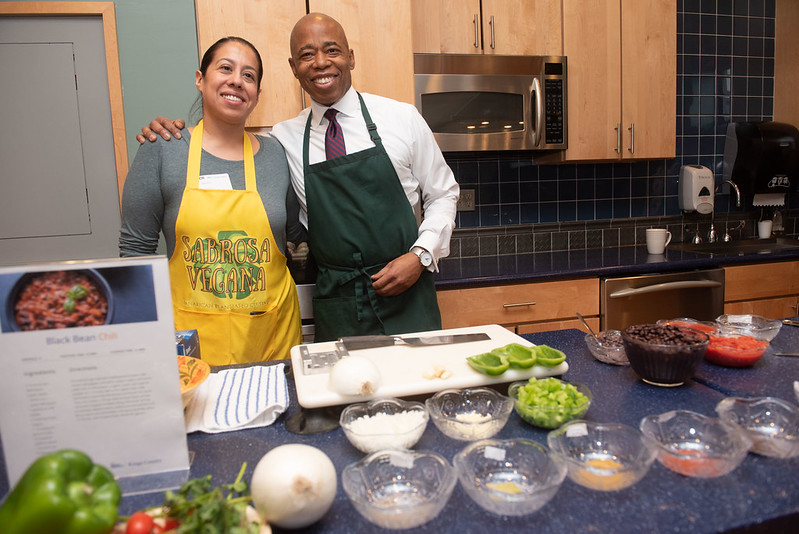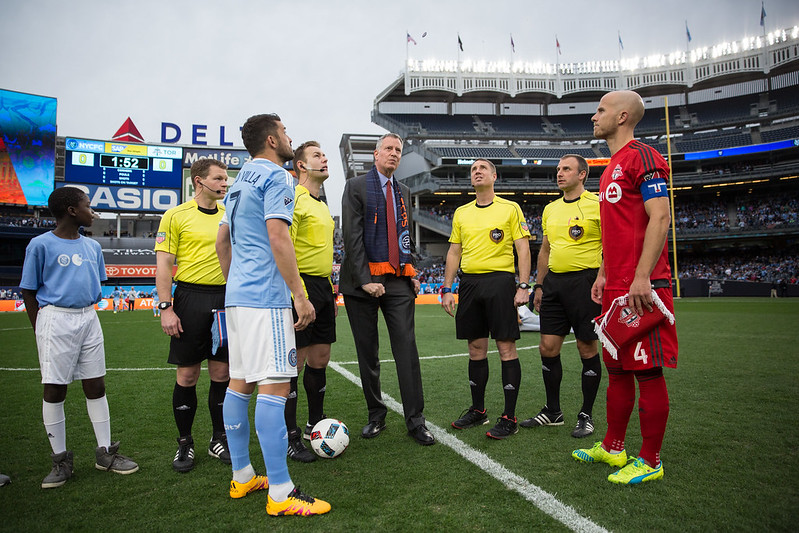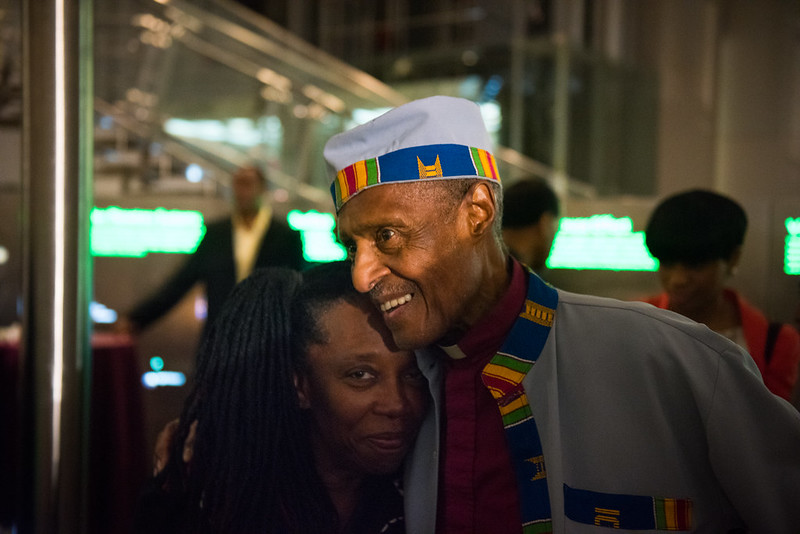Why We Welcome Vegan Fridays in New York City Schools

Mayor Adams at a vegan cooking demo (photo: Michael Appleton/Mayoral Photography Office)
The Adams administration recently announced that plant-based meals, free of animal products except for federally-required fluid milk, would be served across the New York City public school system on Fridays. Mayor Adams had been crystal clear throughout his campaign about the connection between food and health: “We must stop feeding the crisis.”
Because city schools serve nearly 1 million meals each day, rolling out the program citywide presents one of many opportunities to put our public health and sustainability priorities on our plates.
What many city residents may not fully understand is just how powerful food can be in not only preventing disease but also treating it. Adams’ personal experience of reversing type 2 diabetes by eating a diet predominated by unprocessed plant foods – beans, whole grains, vegetables, fruits, nuts, and seeds – is not an anomaly. Countless people affected by diabetes across the country have had results similar to Mayor Adams, and a rising cadre of healthcare professionals affiliated with the American College of Lifestyle Medicine are counseling their patients to eat diets that are primarily comprised of unprocessed plants, along with other positive lifestyle behaviors, as a first line of defense.
And it’s not just diabetes: heart disease, high blood pressure, overweight and obesity, digestive problems (from acid reflux to constipation), elevated cholesterol, and many other health issues count diet as a root cause. What we put in our mouths directly affects all parts of the body as a holistic system. Dietary habits even modify our genes.
What does this have to do with our kids and vegan Fridays? Here are four reasons we welcome the change and other forthcoming health-forward city feeding policies:
Kids are getting sicker at younger ages. It’s no secret that children across the country, and New York City is no exception, are experiencing the same poor health as adults. They are also experiencing high rates of ADHD, anxiety, asthma, and other chronic respiratory conditions. Children are being diagnosed with chronic conditions that used to be seen only in adults, including diabetes, and most children will have fatty streaks in their arteries, the beginning of cardiovascular disease, by the age of 10. We should not take any of these stats as a given.
Disease is not an inevitable result of the imperfect human body but a direct outcome of the poor nutritional environment our country built throughout the 20th century. Dismantling it will take tremendous effort, and our very lives depend on it.
Kids don’t need animal products to meet their nutritional needs, certainly not on a daily basis. While the food groups and the food pyramid we learned about in our childhood incorporated daily animal food consumption as an essential part of a healthy diet – and our parents and grandparents told us the same – the evidence now shows otherwise.
In fact, children across history and today across the country are being raised on well-balanced plant-based diets and thriving. What's more, they have more immune system resilience, lower rates of chronic disease as they age, and healthier weight than their peers. While more research needs to be done, it's clear that one plant-based meal served at school will not create a nutritional deficiency in children. Instead, it will add critical micronutrients and fiber that are only found in plant foods, while reducing consumption of saturated fat and cholesterol, abundant in animal foods.
Serving plant-based meals introduces critical messages that plants are essential for health. As children (and adults) come to learn that plant-based meals are nourishing and even delicious, we can dispel myths and stigmas about plant-based eating. Over time, this will not only breed a culture of tolerance of different eating patterns but also has the potential to give children and families more informed choices about how to eat for health.
Schools are an ideal place for such education, and in the near-term absence of such instruction in the classroom, modeling and sharing this information in the lunchroom is a welcome first step.
Our planet depends on more plant consumption. As climate change looms large in our minds, animal agriculture is the often-unspoken elephant in the room. Raising animals and their byproducts for human consumption contributes substantially to greenhouse gas emissions. Every step our city takes, with its tremendous purchasing power, to reduce our dependence on animal agriculture helps us to return our ecosystems to health and preserve the planet for our children.
But the details matter. Just as with other meal options in schools, palatability and presentation is important. Parents reporting that their kids didn’t care for the new vegan meal on its first Friday should remember that this phenomenon is not limited to the vegan meal and Meatless Mondays, already in place in city schools. In the background, our school system is working hard on cracking the code of providing meals at scale that are both nutritious and delicious, without defaulting to animal products or highly-processed foods.
As healthcare professionals, community nutrition educators, and health-conscious community leaders, we teach about whole food, plant-based nutrition to achieve the health goals we seek, and this includes a steep reduction if not elimination of refined foods like white flours, oils, sugar, and salt. Black bean burritos and Mediterranean chickpeas are a huge step in the right direction.
Here and now, we must prioritize solving our intractable public health issues that have very obvious, even if challenging, solutions. We support Mayor Adams on his quest to bring healthy eating and lifestyle behaviors into the limelight and offer new and empowering paths forward for all.
***
By Lianna Levine Reisner, President & Network Director, Plant Powered Metro New York; Michelle Loy, MD, FAAP, DipABLM; Louise Merriman, MS, RD, CDN; and Aifra Ruiz, Nutrition & Fitness Coach and New York City public school parent leader. Plant Powered Metro New York empowers people to find better health and overcome chronic disease through whole food, plant-based nutrition. On Twitter @PlantPoweredMNY.
***
Have an op-ed idea or submission for Gotham Gazette? Email This email address is being protected from spambots. You need JavaScript enabled to view it.
A Bronx Soccer Stadium for the New Mayor? Maybe

An NYCFC game at Yankee Stadium (photo: Michael Appleton/Mayor's Office)
Is it time for a soccer stadium in the South Bronx now that NYCFC is the Major League Soccer champion and the U.S. is (hopefully) on its way to qualifying for the 2022 World Cup?
Maybe.
A stadium built expressly for soccer could serve as a hub for this global sport in our global city. In addition to serving the home team (NYCFC) it could attract clubs from every continent for exhibition games, drawing fans from New York’s diverse communities. Imagine: Argentina vs. its former colonial ruler, Spain; France vs. Germany; South vs. North Korea. The match-ups would feed the ethnic pride of neighborhoods from Queens to Brooklyn, Manhattan to Staten Island, and of course in the Bronx.
A gleaming new stadium outfitted with high-tech screens, lounges, interactive consoles for fan engagement, and instant access to color commentators, coaches, and players would be a cathedral for soccer. As Yankee Stadium is to baseball, an NYCFC stadium would be a mecca for American soccer. And the same mass transit-rich hub that serves 50,000 fans of The Bronx Bombers each game would easily accommodate 25,000 fans of the Boys in Blue. There are three subway lines (B, D, and 4 ), a new Metro-North station, and three MTA bus lines. Easy to get to; easy to leave.
A soccer-specific stadium alongside Yankee Stadium, the Universal Hip Hop Museum, The Bronx Children’s Museum, and a few blocks from Pregones Theatre, the Hostos Center for Arts and Culture, Andrew Freedman Mansion, and The Bronx Museum could further enrich a diverse cultural corridor second to none in New York City. Sports and Salsa and drama and art and film and dance. All together in one square mile. Activities, events, and joy for people of all ages and inclinations.
Or maybe not.
A new stadium won’t work if it ignores the vital needs of its host community, one of the poorest in the country. The South Bronx can’t afford to be victimized like it was when the new Yankee Stadium was built. Former Mayor Bloomberg gave then-Yankee owner George Steinbrenner a sweetheart deal: no property taxes and only $1 per year in rent.
Like Steinbrenner, the NYCFC owner, Sheikh Mansour bin Zayed Al Nahyan, is one of the world’s wealthiest people, and the community is still plagued by poverty and despair. A new South Bronx soccer stadium won’t work if it deprives the neighborhood of the revenue it deserves for housing, health care, and combating hunger and unemployment.
A new stadium can’t work if it turns the neighborhood into a mini-Vegas, filled with slot machines, sports betting kiosks, and 24-hour-a-day gambling. The debauchery that accompanies urban betting palaces is at odds with the religious, family-focused nature of South Bronx neighborhoods like Concourse Village, Melrose, and Morrisania. Recently, many major league sports teams and leagues are partnering with gaming companies like Bally’s, Resorts International, and Caesars. In Madrid, they are even building a new soccer facility that will be half-soccer stadium and half-casino. But, in a recent survey of residents, business owners, and employees in The South Bronx, only 33% favored a casino-stadium hybrid.
Maybe not. If the arena doesn’t have a dome so it can be utilized year-round for concerts, conventions, and convocations. If it isn’t accessible for use by local teams. If it doesn’t have a professional women’s soccer team. If it doesn’t include a youth center for those who favor e-sports or need coaching or a refuge from any number of things. If it doesn’t provide local businesses with preferential rents in the stadium.
If the stadium is environmentally irresponsible. If it will result in more pollution than it mitigates in the neighborhood. The South Bronx is sadly known as “Asthma Alley” and the borough ranks last in health among New York State’s 62 counties. If a stadium results in more traffic jams made up of idling Ubers, Lyfts, and taxis spewing fumes into the lungs of residents and preventing safe passageways for pedestrians and residents, we don’t need it.
Or definitely not.
Unless the team owners partner with the neighborhood and offer those who work, live, serve, or own businesses and property a piece of the pie. A New York City soccer stadium will be an enormously valuable asset worth billions of dollars. There’ll be naming rights (Facebook Field?), broadcast fees (for MLS games, exhibition games, and World Cup matches), corporate sponsorships, merchandising and ticket sales. The South Bronx deserves to benefit as partners from any and all of these revenue streams. This host community has earned the right to be paid for its nine decades of hospitality and the infrastructure it would provide for a new stadium.
Or definitely.
If Mayor-elect Adams endorses our partnership idea and makes a Neighborhood Ownership Plan a symbol of his administration’s commitment to inclusion, diversity, and equity.
***
Dr. Cary Goodman, a sports sociologist, is the executive director of the 161st Street Business Improvement District around Yankee Stadium.
***
Have an op-ed idea or submission for Gotham Gazette? Email This email address is being protected from spambots. You need JavaScript enabled to view it.
The Continual Discovery of Our City’s Past, in Black History Month and Beyond

Black History Month (photo: Edwin J. Torres/Mayoral Photography Office)
Each February, we celebrate the achievements of towering singular figures — icons who paved the way for Black Americans to have a more just and dignified existence in the United States. Indeed, they should be lauded for their accomplishments, but we must also remember the innumerable people whose experiences constitute the whole of Black histories.
There are many nonprofits that promote and preserve New York City’s rich cultural heritage. These nonprofits are doing exemplary work to ensure that the city’s tapestry of stories includes local artists, activists, laborers, and historians that may otherwise be little known. This is important for a few reasons: it portrays more accurate narratives about historically-marginalized groups; paints a fuller picture of histories that are as diverse as the people who live them; and leads to a better understanding of our past so we can expand the possibilities of our future.
One little known story in our city begins in 1969 Brownsville, where Mother Rosetta Gaston created the Children’s Cultural Corner in her home to pass down African-American history and culture to younger generations. Today, known as the Brownsville Heritage House, it is situated on the second floor of the Brooklyn Public Library’s Stone Avenue Branch and continues to preserve local heritage through the arts, education, and history.
BlackSpace, a collective of Black urbanists, is working with the House to shore up its activities as a community hub. This includes developing an archive of its 500-artifact collection, plus items from local residents that highlight Brownsville’s histories of changing demographics, progressive organizing, and Black Arts Movement-inspired schools.
Another effort that is bringing everyday stories to light is underway in Staten Island. The Staten Island Museum is working with the Richard B. Dickenson Chapter of the Afro-American Historical and Genealogical Society and Frederick Douglass Memorial Park, an African-American cemetery, to digitize Census and burial records and make Black family histories more accessible.
Of particular significance is a museum card catalog that Dickenson, the late borough historian, created with entries for every mid- to late-19th century African-American resident on the Island. The U.S. Census largely excluded Black people until 1870, so records before this period are especially informative for families tracing their ancestry.
In Upper Manhattan, the Dyckman Farmhouse uncovered the names and stories of enslaved people and indentured servants who built the building in the 1800s and worked there, but whose historical presence was made invisible. This history came to life at the Farmhouse in 2020 through an installation by the artist Reggie Black. He projected “Slaves Lived Here” onto the building, literally bringing to light the stories of laborers at the site and in the surrounding Inwood neighborhood.
To make the stories of today available to future generations, African Voices Communications, known for its literary magazine and women’s film festival, is working with Spelman College. They are digitizing and archiving back issues of its magazine and database of films to preserve fiction, poetry, and other artwork from the African diaspora. Functioning as a permanent repository, the college will make the records accessible online for a broader public.
Black History Month is a reminder to rededicate ourselves to an ongoing study of the past, a process that should begin with looking at all the histories that brought us to where we stand today.
The New York Community Trust supports groups that are preserving these stories and making them widely available. We hope others will join us in this continual discovery of our city’s past by visiting cultural institutions that steward Black histories, as well as encouraging friends and family to do the same. These histories can be a source of new inspiration from a city whose true wealth—its people—always renews us with hope for the future.
***
Salem Tsegaye is the program officer for arts, culture, and historic preservation at The New York Community Trust -- the community foundation for New York City, with divisions in Westchester and Long Island. On Twitter @SalemTsegaye of @NYCommTrust.
***
Have an op-ed idea or submission for Gotham Gazette? Email This email address is being protected from spambots. You need JavaScript enabled to view it.




